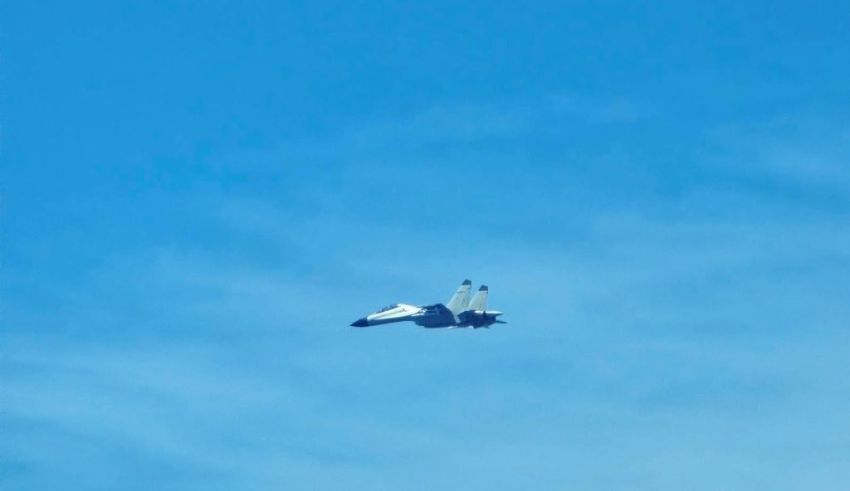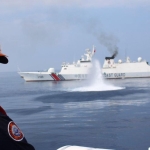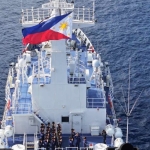
Strong and urgent appeal to China has been sent by the Philippine government, demanding an immediate stop of all provocative and dangerous activities endangering the safety of Philippine vessels and aircraft engaged in lawful operations inside the territory and Exclusive Economic Zone (EEZ). This request relates to a recent incident whereby China fired lights from its militarily reclaimed island on Zamora Reef, aiming at a Bureau of Fisheries and Aquatic Resources (BFAR) aircraft engaged in regular patrols in the vicinity.
Rising Tension Over the West Philippine Sea
Just days following the August 22 flare incident, the National Task Force in the West Philippine Sea (NTF-WPS), in charge of defending the Philippines’ maritime interests, issued this severe warning. On a normal patrol meant to monitor and intercept illicit activity, including poaching, within the Philippines’ EEZ and the territorial waters of the Kalayaan Island Group, the BFAR aircraft—a Cessna 208B Grand Caravan—was on a Maritime Domain Awareness (MDA) flight. Rich in sea resources, this area has been the center of many territorial conflicts between China and the Philippines.
Emphasizing that the flares were unfairly used from Zamora (Subi) Reef, the NTF-WPS voiced great worry and criticism over China’s activities. International law—more especially, the United Nations Convention on the Law of the Sea (UNCLOS)—allows this reef, which is barely 26 kilometers southwest of Pag-asa Island, to be clearly under Philippine control. The task team pointed out that China’s forceful behavior not only goes against international standards but also increases tensions in an already unstable area.
Consistent Aggression Against Philippine Aircraft
The August 22 flare incident did not represent a one-off instance of Chinese provocation. Just three days prior, on August 19, the same BFAR aircraft was harassed by a Chinese People’s Liberation Army Air Force (PLAAF) fighter jet during another MDA fly close to Bajo de Masinloc (Scarborough Shoal.). The NTF-WPS claims that Chinese Fighter Jet 63270 participated in a sequence of “irresponsible and dangerous maneuvers,” including repeated flare discharge at an uncomfortably close distance of roughly 15 meters from the BFAR Grand Caravan aircraft.
The NTF-WPS underlined that the Chinese fighter jet’s conduct were unposed and clearly intended to risk the lives of the BFAR soldiers on board. China’s reckless actions aggravate the already difficult scenario in the South China Sea, where several countries have conflicting claims. Particularly following the 2016 Arbitral Tribunal decision, which invalidated China’s broad claims in the area, the Philippines has been very vociferous in maintaining her sovereign rights.
Keep Reading
Effect on Relations, Regional and International
The latest flare episode and ongoing intimidation of Philippine planes have broad consequences for international relations and regional stability. The NTF-WPS said that China’s forceful activities compromise region peace and security, therefore tarnishing China’s reputation among the world community. Conversely, the Philippines has reaffirmed its will to defend its sovereign rights, especially in relation to increasing maritime domain awareness inside its territorial waters, national airspace, EEZ, and the high seas.
The Philippines’ posture is firmly based on international law, especially UNCLOS and the 2016 Arbitral Award, which validated its claims in the South China Sea. China has kept claiming its presence in the area militarily and aggressively, despite the decision, which has resulted in regular conflicts with other claimant countries such the Philippines, Vietnam, Malaysia, and Brunei.
Reacting to the most recent provocations, the Philippine government has urged a united posture among the Southeast Asian countries and the larger global community to offset China’s assertiveness in the South China Sea. To strengthen its defense capacity and guarantee the safeguarding of its marine interests, the Philippines has also stepped up its diplomatic activities, interacting with friends including the United States, Japan, and Australia.
More General Effects on the Conflict Over the South China Sea
Part of a larger geopolitical conflict in the South China Sea, one of the most strategically significant and disputed areas worldwide, the continuous tensions between the Philippines and China in the West Philippine Sea reflect With about one-third of world trade traveling across its seas, the South China Sea is not only rich in natural resources—including fisheries and possible oil and gas reserves—but also a vital marine route.
China’s vast assertions, summed up in the so-called “Nine-Dash Line,” span almost the whole South China Sea and conflict with numerous Southeast Asian countries results from them. Like what the Philippines has gone through, these conflicts have resulted in a sequence of confrontations including the building of artificial islands, the setting of military bases, and events of naval and aircraft harassment.
With many nations demanding respect of international law and the peaceful resolution of problems, the international community has grown more concerned about China’s activities in the South China Sea. Particularly the United States has carried Freedom of Navigation Operations (FONOPs) in the area, therefore undermining China’s assertions and so bolstering the rights of other countries to unhindered navigation of the South China sea.
The situation in the South China Sea stays a possible trigger for more general regional conflict as tensions boil. Apart from defending its national sovereignty, the Philippines’ demand of China to stop its risky activities appeals more generally for the preservation of peace and stability in the area. The result of this continuous conflict will have major consequences not only for China and the Philippines but also for the whole Asia-Pacific area and the world community at big scale.





























